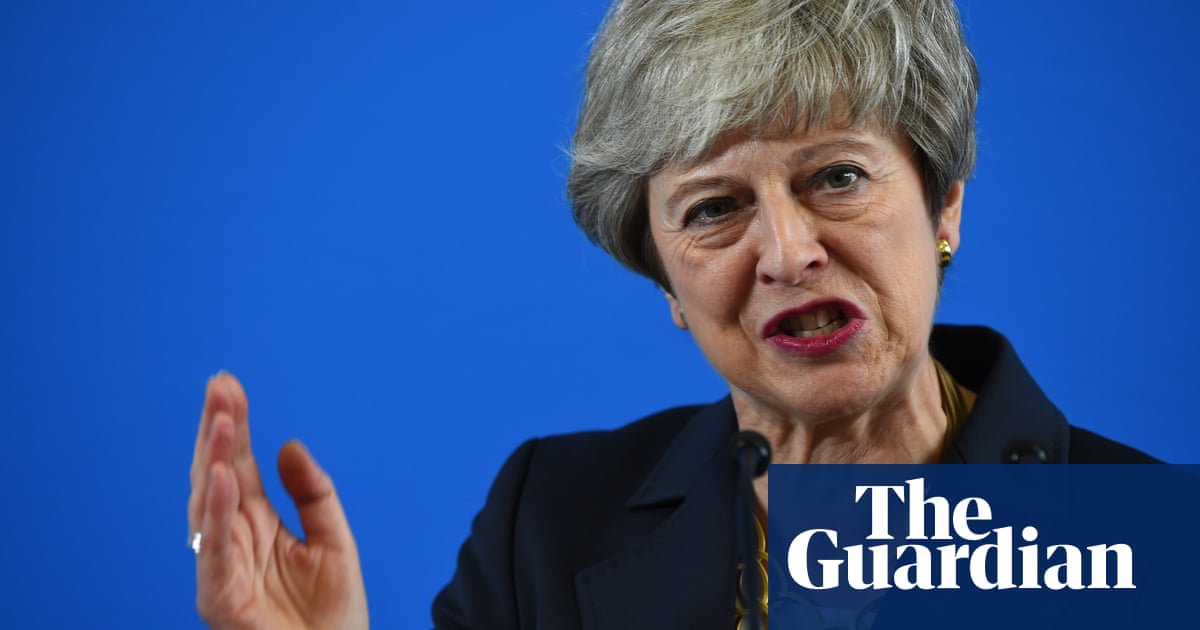
The words “unpredictable” and “unprecedented” are increasingly used to describe the Alice in Wonderland political situation in London. Less than two weeks before the United Kingdom is scheduled to leave the EU, the nation stands at a historic crossroads.
MPs voted 413-202 on Thursday to request permission from Brussels to negotiate an extension to the withdrawal date. However, Conservative Prime Minister Theresa May is planning early this week to put the UK withdrawal deal she negotiated with the EU to a parliamentary vote for a third time.
Remarkably, May — after two massive, historic defeats on the defining legislation of her government — has a glimmer of hope of victory next week. In previous political eras, by now she would probably have quit as prime minister or been forced out of office. Yet while the odds are still stacked against her, there are signs that she might “lose her way to victory” before an EU summit of presidents and prime ministers this Thursday and Friday.
To be sure, May’s premiership is still hanging by a thread. But it is nonetheless the case that a critical mass of hard-line Brexiteers in her Conservative Party, and possibly the Northern Irish Democratic Unionist Party (DUP) too, could now decide to back her withdrawal deal as the least-bad choice, given their growing fear that the UK might otherwise never leave.
To grind out a win, May needs to reverse the two historic defeats of her Brexit deal in the House of Commons, by 202-432 votes on January 15 and by 242-391 on March 12. A key reason she lost the second ballot was because only 43 of the 118 Tory MPs who voted against her deal in January switched to the Government’s side.
There is no path to victory for May without winning many more of the Brexiteers’ votes. As part of a potential “grand bargain” with these “Euroskeptics,” who are growing increasingly disillusioned with May, it is even possible that she might offer to stand down as prime minister to get the withdrawal deal over the line.
If she is to win, one leading indicator could be whether the 10 DUP MPs, who prop up her minority government, also get behind her deal. Like many of the hard-line Brexiteers in May’s own party, the primary reason the DUP members have not endorsed her withdrawal deal is the issue of the so-called Irish backstop. This aims to address the potential problems posed by the border between Northern Ireland, which is part of the UK, and the Republic of Ireland, which is a member of the EU.
Even if May manages to pull victory from the jaws of defeat, she already appears to have waved the white flag as regards her long-planned ambition of the United Kingdom leaving the EU on March 29.
Andrew Hammond
On Friday, there were signs that the Government might be making some progress. Not only do some high-profile Conservatives, including former cabinet minister Esther McVey, now support the deal but the DUP is said to be in “ongoing, significant” discussions with Downing Street.
What many Brexiteers and the DUP are looking for is more political cover if they support May. This includes the possibility that Attorney General Geoffrey Cox could make additional provisions to UK law to fortify the perceived safeguards on the Irish backstop. Crucially, this might also lead him to change his legal advice on this issue. What the Brexiteers and the DUP want to hear is that the risk has materially reduced, if not eliminated outright, of the United Kingdom getting stuck in a permanent arrangement that would leave the nation effectively tied up in a customs union with the EU.
Yet even if May brings the DUP and a critical mass of Brexiteers over the line to her side, she also needs the support of significantly more Labour backbenchers too. On Tuesday, she failed to attract any more of the Labour MPs who represent constituencies that voted leave in the 2016 referendum, beyond the three who voted for her deal in January.
Even if May manages to pull victory from the jaws of defeat, she has already waved the white flag as regards her long-planned ambition of the UK leaving the EU on March 29. Even if her deal is approved by parliament this week, she will need to ask the EU for an extension of the leaving date until May or June. If her deal falls again, and there is no attempt at a fourth vote, there might be a longer extension, possibly until at least December 2020, which is when the planned transition period, had a withdrawal been agreed, was planned to end.
While it is most likely the other 27 EU governments will agree to a UK request to extend the deadline, it is not certain. The full complement of presidents and prime ministers have not formally discussed this option together, and with populist Euroskeptics expected to make big gains in May’s European Parliament elections, some leaders are worried that Brexit could continue to “pollute” the EU agenda.
A long extension would also not be plain sailing for the UK government. Brussels might attach tough conditions, and it would add to the growing possibility of a second UK referendum, something May opposes.
So while the odds are still against her, May could yet lose her way to victory on her withdrawal deal next week. Much will depend upon the position of hard-line Brexiteers and the DUP, as they calculate whether it is better to fall in line behind the prime minister, or face a potentially lengthy Article 50 extension that might last until at least 2020 and risk Brexit being jeopardized by a second referendum.
Andrew Hammond is an Associate at LSE IDEAS at the London School of Economics
Disclaimer: Views expressed by writers in this section are their own and do not necessarily reflect Arab News" point-of-view












